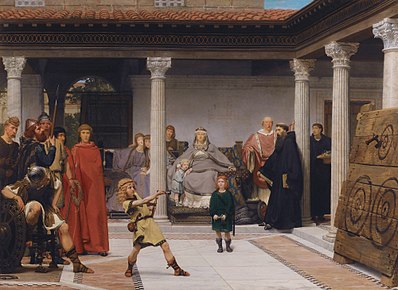
MARY COPELAND – VICTORIAN DETECTIVE: ALMA-TADEMA PART 1
The second story of the collection features a painting titled The Roses of Heliogabalus. It was painted by Lourens Alma-Tadema (Dronrijp, January 8, 1836 – Wiesbaden, June 25, 1912). This originally Dutch painter caused a furore in Victorian England. He was born as Lourens Tadema, but later added his godfather’s name to become Alma Tadema. He wrote the name without a hyphen. In my books, however, the hyphen is in between, which is why I do that here as well. He added that middle name – he had a good business instinct – to get to the front of the catalogue of exhibitions. From Dronrijp the family in which he grew up moved to Leeuwarden, the capital of the Dutch province of Friesland. He went to high school there and he was supposed to study law, but he became seriously ill at the age of fifteen and from then on he was allowed to devote all his time to drawing and painting. He got better and from then on pursued a career as a painter.
In 1852 he entered the art academy in Antwerp. He immersed himself in early Netherlandish and Flemish painting. He graduated four years later. In the meantime, he had already won many awards. Inspired by stories about the Merovingian period, he started to paint about it. He was already very detailed and substantiated his performances with a lot of research, which would later become a ‘trademark’ of his. His best-known work from that time is The Education of the Children of Clovis from 1861. It is included with this blog.
Alma-Tadema married Marie-Pauline Gressin Dumoulin in 1863, with whom he had three children. Their son died of smallpox after only a few months. However, the daughters Anna and Laurence survived and would later become known in the fields of literature and painting. The couple’s honeymoon took them to Italy, including Rome and Pompeii, where Alma-Tadema was inspired for the rest of his life to dedicate his paintings to that classical antiquity. However, Alma-Tadema was again deeply saddened when his wife also died of smallpox in 1869. There followed several years in which he was devastated, his sister came to take care of his daughters and his health left much to be desired. During a visit to England, he fell deeply in love with Laura Theresa Epps, who was then seventeen years old. During the Prussian-French War of 1870 he moved to England. Paris was not safe, he was in love and his agent thought he could find more buyers for his work in England. Alma-Tadema married Laura Epps in 1871. She also became a well-known painter, especially of still lifes. This second marriage was long and happy, but remained childless. Laura became the stepmother of Laurence and Anna. In my book they are good friends of Mary. Since Mary’s aunt and uncle became friends with the family, Mary came to the artist’s house from an early age.
Alma-Tadema’s career took off in London. He became one of the most in-demand and richest artists of his time. He was heavily influenced by the Pre-Raphaelite painters, especially in the use of colour and lighter brushwork. Once in England he changed his first name to Lawrence.
In one of the next blogs I will continue with the life and work of this great painter, because there is so much more to write about him.
With kind regards,
Robbert Jan.


Post Views : 267